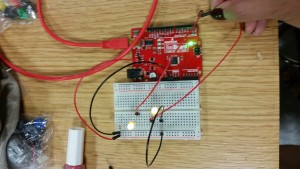For this project, I used yellow, red, and green lights that would turn on to their designated colored switches, and programmed them all to blink in a coordinated pattern with each other. Mostly, when making this project, I just kept thinking about Christmas. And while I couldn’t have snow or presents, I could at least program a tiny version of Christmas lights, while listening to carols during the project for a partial effect.
Apart from the finickiness of the switches and getting the wires to line up on the breadboard, the project was relatively easy to execute.
Initially, I tried to remember everything we learned from Wednesday’s class on programming and switches using photos I took from the class. Once I figured out how to turn on one yellow light with three switches, it became smooth sailing from there on what my errors were and how to fix them.
For this project, I used two red, two green, and two yellow lights, and the pairs were wired in parallel with each other so that they’d both turn on to the same switch input.
When you press the green button, the two green lights will light up at a specific pattern shown below in my coding. Likewise, when pressing the red button, the red lights would light up at a slightly faster speed, to light up whenever the green lights were off. And finally, when pressing the yellow button, the yellow lights will turn on when the other two lights are off. When pressing all three switches, the lights essentially light up in the sequence: green, then red, then yellow.
In order to make the lights work in parallel, the long ends are stuck in the same pin hole, and the short ends are put in the same row as 330 ohm resistors connected to ground. The switches are connected to the ground with a wire, and then a 10K ohmm resister in the row connected to the RedBoard.
When programming, I basically had three sections, with each switch connected to the designated color lights. Below is the chart I used to identify which switch went to which pin since it got confusing after a while with the wiring.
Switch in pin 3 turns on pin 7 green lights
Switch in pin 5 turns on pin 6 red lights
Switch in pin 4 turns on pin 2 yellow lights
Below is a video of how it works, and a copy of my coding:
CODING:
void setup() {
// put your setup code here, to run once:
//SWITCH Green
pinMode(3,INPUT);
// SWITCH Yellow
pinMode(4,INPUT);
// SWITCH Red
pinMode(5,INPUT);
//Red
pinMode(6,OUTPUT);
//Green
pinMode(7,OUTPUT);
//Yellow
pinMode(2,OUTPUT);
}
void loop() {
// put your main code here, to run repeatedly:
if(digitalRead(3) == HIGH){
digitalWrite(7,HIGH);
delay(250);
digitalWrite(7,LOW);
delay(750);
} else {
digitalWrite(7,LOW);
}
if(digitalRead(5) == HIGH){
digitalWrite(6, HIGH);
delay(100);
digitalWrite(6,LOW);
delay(500);
} else {
digitalWrite(6, LOW);
}
if(digitalRead(4) == HIGH){
digitalWrite(2,HIGH);
delay(50);
digitalWrite(2,LOW);
delay(250);
}else{
digitalWrite(2,LOW);
}
}


